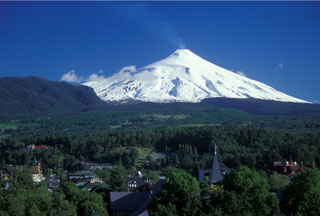Report on Villarrica (Chile) — 1 September-7 September 2010
Smithsonian Institution / US Geological Survey
Weekly Volcanic Activity Report, 1 September-7 September 2010
Managing Editor: Sally Sennert.
Please cite this report as:
Global Volcanism Program, 2010. Report on Villarrica (Chile) (Sennert, S, ed.). Weekly Volcanic Activity Report, 1 September-7 September 2010. Smithsonian Institution and US Geological Survey.
Villarrica
Chile
39.42°S, 71.93°W; summit elev. 2847 m
All times are local (unless otherwise noted)
Based on analyses of satellite imagery, the Buenos Aires VAAC reported that on 4 September a diffuse ash plume from Villarrica, possibly containing steam and gas, drifted NE.
Geological Summary. The glacier-covered Villarrica stratovolcano, in the northern Lakes District of central Chile, is ~15 km south of the city of Pucon. A 2-km-wide caldera that formed about 3,500 years ago is located at the base of the presently active, dominantly basaltic to basaltic andesite cone at the NW margin of a 6-km-wide Pleistocene caldera. More than 30 scoria cones and fissure vents are present on the flanks. Plinian eruptions and pyroclastic flows that have extended up to 20 km from the volcano were produced during the Holocene. Lava flows up to 18 km long have issued from summit and flank vents. Eruptions documented since 1558 CE have consisted largely of mild-to-moderate explosive activity with occasional lava effusion. Glaciers cover 40 km2 of the volcano, and lahars have damaged towns on its flanks.

